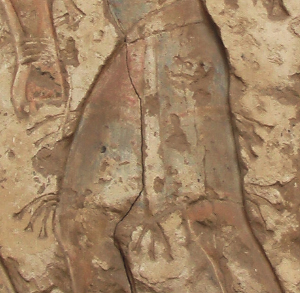Offerings from the Land and Other Laws (15:1–41)
For special vows or freewill offerings or festival offerings (15:3). Vows involved a verbal act of commitment to a task or to consecration of oneself or one’s property to the Lord; sacrificial offerings (votive) were part of the obligation or, in the case of the Nazirite, oaths of abstinence.118 The peace, vow, and freewill offerings were of the communion type, in which certain portions of the animals were offered to God as a savory aroma,119 and the remainder were consumed by the priests and the offerer in the communal setting of the tabernacle or temple. Hence, the totality of the Israelite community engaged in a corporate meal that celebrated the unity of the community of faith.
Unlike the descriptions noted in Mesopotamian ritual texts, which depict the gods as consuming the sacrifices as necessary to their survival,120 God’s pleasure in the Israelite sacrifices is described in anthropomorphic terms of a pleasing aroma that ascends in the smoke into the invisible realm of the heavenly abode.
The first of your ground meal (15:20). During the spring harvest of barley and wheat (the season of Passover, Unleavened Bread, and Pentecost), the grain firstfruit offering was presented to God. Even the mundane daily practice of kneading dough for making bread was a time of worship and celebration of God’s benevolence and faithfulness. The first or choicest dough made from the first coarsely ground flour of the season was set aside for honoring God.
Bread was the essential food staple, and hence a sacred sacrifice was rendered back to God as the giver of life and the provider of grain from which the bread was made. Similarly, wine and grapes from the vineyard, olive oil and olives from the orchard, and fruit juices from the fall fruit harvest were offered unto God. According to 18:11–16, all firstfruits and products brought to Yahweh were supplied to the priests.
Sins defiantly (15:30). The raised right hand with the outstretched arm was a common symbol of strength and power in ancient Near Eastern literature and iconography.121 The sinner with a high hand feels no guilt; thus, the offense is not sacrificially expiable. Such a defiant person must suffer the ultimate of judgment, the “cutting off” (karet) reserved for the most heinous or sacrilegious offenses.122 Milgrom delineates five categories of infractions in which the karet was meted out: (1) violation of sacred time, as in the neglect of certain holy days, (2) violation of sacred substance, such as in the consumption of blood, (3) neglect of purification ritual, such as circumcision, (4) illicit worship, such as idolatry or sorcery, and (5) illicit sexual activity, such as incest or bestiality.123
Tassels (15:38). In the ancient Near East, special garments were made for priests and royalty that identified them within their communities and to the outside world. Several examples of garments with corded fringes come from the statue of Puzur-Ishtar, governor of Mari in the Ur III period (ca. 2060–1955 B.C.), from Asiatics depicted in the Beni Hasan tomb of the Egyptian Khnum-hotep II in the nineteenth century B.C., and from later Neo-Assyrian murals.124

Egyptian relief showing tassels on Asiatic garment
Manfred Näder Gabana Studios Germany